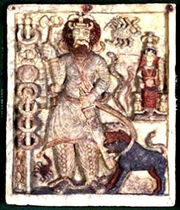
Nergal
The name Nergal, Nirgal, or Nirgali (Hebrew: נֵרְגַל, Modern Nergal Tiberian Nērḡál; Aramaic ܢܹܪܓܵܐܠ; Latin: Nergel) refers to a deity in Babylon with the main seat of his cult at Cuthah represented by the mound of Tell-Ibrahim. Nergal is mentioned in the Hebrew Bible as the deity of the city of Cuth (Cuthah): "And the men of Babylon made Succoth-benoth, and the men of Cuth made Nergal" (2 Kings, 17:30). According to the rabbins, his emblem was a cock and Nergal means a "dunghill cock". He is the son of Enlil and Ninlil.
Attributes[]
Nergal actually seems to be in part a solar deity, sometimes identified with Shamash, but only a representative of a certain phase of the sun. Portrayed in hymns and myths as a god of war and pestilence, Nergal seems to represent the sun of noontime and of the summer solstice that brings destruction, high summer being the dead season in the Mesopotamian annual cycle.
Nergal was also the deity who presides over the netherworld, and who stands at the head of the special pantheon assigned to the government of the dead (supposed to be gathered in a large subterranean cave known as Aralu or Irkalla). In this capacity he has associated with him a goddess Allatu or Ereshkigal, though at one time Allatu may have functioned as the sole mistress of Aralu, ruling in her own person. In some texts the god Ninazu is the son of Nergal and Allatu/Ereshkigal.
Ordinarily Nergal pairs with his consort Laz. Standard iconography pictured Nergal as a lion, and boundary-stone monuments symbolise him with a mace surmounted by the head of a lion.
Nergal's fiery aspect appears in names or epithets such as Lugalgira, Lugal-banda (Nergal as the fighting-cock), Sharrapu ("the burner," a reference to his manner of dealing with outdated teachings), Erra, Gibil (though this name more properly belongs to Nusku), and Sibitti or Seven. A certain confusion exists in cuneiform literature between Ninurta (slayer of Asag and wielder of Sharur, an enchanted mace) and Nergal. Nergal has epithets such as the "raging king," the "furious one," and the like. A play upon his name—separated into three elements as Ne-uru-gal (lord of the great dwelling) -- expresses his position at the head of the nether-world pantheon.
In the late Babylonian astral-theological system Nergal is related to the planet Mars. As a fiery god of destruction and war, Nergal doubtless seemed an appropriate choice for the red planet, and he was equated by the Greeks either to the combative demigod Heracles (Latin Hercules) or to the war-god Ares (Latin Mars) -- hence the current name of the planet. In Babylonian ecclesiastical art the great lion-headed colossi serving as guardians to the temples and palaces seem to symbolise Nergal, just as the bull-headed colossi probably typify Ninurta.
Nergal's chief temple at Cuthah bore the name Meslam, from which the god receives the designation of Meslamtaeda or Meslamtaea, "the one that rises up from Meslam". The name Meslamtaeda/Meslamtaea indeed is found as early as the list of gods from Fara while the name Nergal only begins to appear in the Akkadian period. Amongst the Hurrians and later Hittites Nergal was known as Aplu, a name derived from the Akkadian Apal Enlil, (Apal being the construct state of Aplu) meaning "the son of Enlil". As God of the plague, he was invoked during the "plague years" during the reign of Suppiluliuma, when this disease spread from Egypt.
The cult of Nergal does not appear to have spread as widely as that of Ninurta, but in the late Babylonian and early Persian period, syncretism seems to have fused the two divinities, which were invoked together as if they were identical. Hymns and votive and other inscriptions of Babylonian and Assyrian rulers frequently invoke him, but we do not learn of many temples to him outside of Cuthah. Sennacherib speaks of one at Tarbisu to the north of Nineveh, but significantly, although Nebuchadnezzar II (606 BC - 586 BC), the great temple-builder of the neo-Babylonian monarchy, alludes to his operations at Meslam in Cuthah, he makes no mention of a sanctuary to Nergal in Babylon. Local associations with his original seat—Kutha—and the conception formed of him as a god of the dead acted in making him feared rather than actively worshipped.
In demonology[]
Being a deity of the desert, god of fire, which is one of negative aspects of the sun, god of the underworld, and also being a god of one of the religions which rivaled Christianity and Judaism, Nergal was sometimes called a demon and even identified with Satan. According to Collin de Plancy and Johann Weyer, Nergal was depicted as the chief of Hell's "secret police", and worked as an "an honorary spy in the service of Beelzebub".